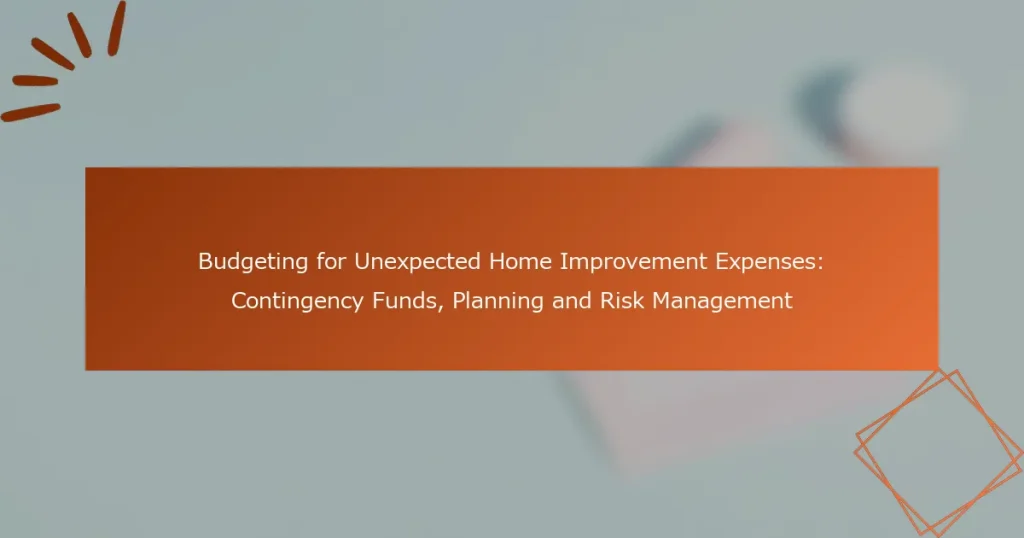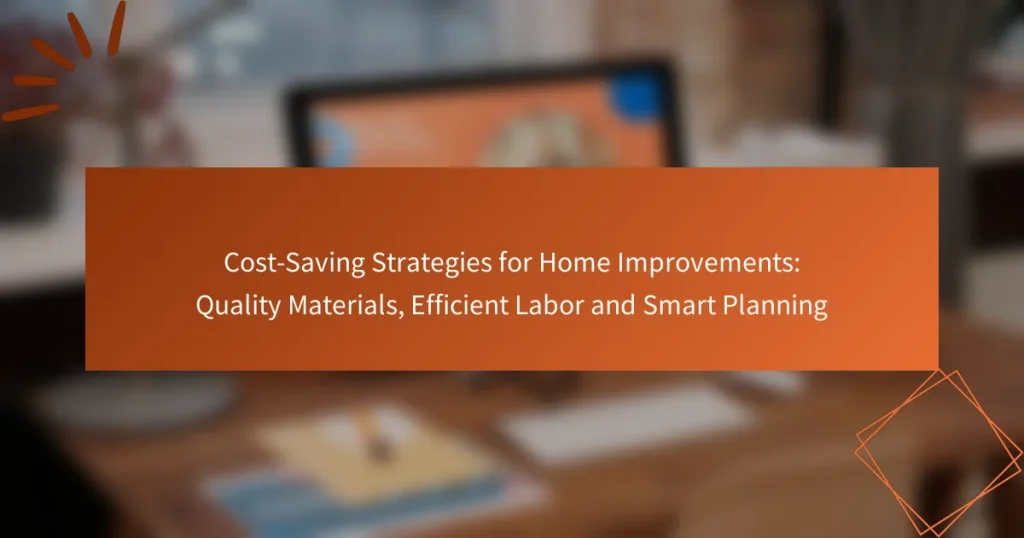日本の住宅改善サービスは、リノベーションの種類や使用する材料、地域の要因によってコストが大きく異なります。予算を立てる際は、全体の予算を決定し、プロジェクトの各側面に資金を適切に配分することが重要です。
Market Trends Impacting Home Renovation Costs: Economic Factors, Seasonal Changes and Demand
Budgeting for Unexpected Home Improvement Expenses: Contingency Funds, Planning and Risk Management
Cost-Saving Strategies for Home Improvements: Quality Materials, Efficient Labor and Smart Planning
Home Improvement Services in Japan: What are the costs?
Home improvement services in Japan can vary significantly in cost depending on the type of renovation, materials used, and regional factors. Generally, homeowners should budget for a range of expenses to ensure they can achieve their desired improvements without financial strain.
Average costs for renovations
The average costs for home renovations in Japan typically range from several hundred thousand yen to several million yen, depending on the scope of work. Minor updates, such as painting or flooring, may cost around 100,000 to 500,000 yen, while major renovations like kitchen or bathroom remodels can exceed 1 million yen.
It’s essential to obtain multiple quotes from contractors to compare prices and services. This practice can help identify the best value for your specific renovation needs.
Cost breakdown by service type
Different types of home improvement services come with varying costs. For instance, kitchen renovations usually involve higher expenses due to cabinetry and appliances, averaging around 1 million to 2 million yen. In contrast, bathroom remodels may range from 500,000 to 1.5 million yen.
Exterior renovations, such as roofing or siding, can also be costly, often falling between 800,000 and 2 million yen. Understanding these averages can help homeowners prioritize their projects based on budget and necessity.
Regional cost variations in Japan
Costs for home improvement services can differ significantly across Japan’s regions. Urban areas like Tokyo and Osaka typically have higher labor and material costs, with renovations often being 20-30% more expensive than in rural areas.
In contrast, regions such as Hokkaido or Kyushu may offer lower prices due to reduced demand and competition among contractors. Homeowners should consider these regional differences when planning their budgets to ensure they allocate sufficient funds for their projects.
How to budget for home improvement projects?
Budgeting for home improvement projects involves estimating costs and allocating funds effectively. Start by determining your overall budget and then break it down into specific categories to ensure all aspects of the project are covered.
Creating a home improvement budget
To create a home improvement budget, begin by listing all the projects you plan to undertake. Assign a rough estimate for each project based on research or quotes from contractors. It’s advisable to set aside an additional 10-20% of your budget for unexpected expenses that may arise during the project.
Consider using a spreadsheet or budgeting app to track your expenses and adjust your budget as needed. This will help you stay organized and ensure that you do not overspend.
Factors influencing budgeting decisions
Several factors can influence your budgeting decisions for home improvement projects. The size and scope of the project, the materials chosen, and labor costs are primary considerations. For example, a kitchen remodel can range from a few thousand to tens of thousands of dollars depending on the quality of materials and complexity of the work.
Additionally, local market conditions and regulations can impact costs. It’s important to research local prices and consult with professionals to get accurate estimates. Always consider the potential return on investment for each project, as some improvements may significantly increase your home’s value.
What are the most common home improvement services?
Common home improvement services include kitchen remodeling, bathroom renovations, and exterior upgrades. These services enhance both functionality and aesthetics, often increasing property value.
Kitchen remodeling services
Kitchen remodeling services focus on updating and optimizing the kitchen space. This can involve changing the layout, upgrading appliances, installing new countertops, or adding storage solutions.
When planning a kitchen remodel, consider your budget, the style you want, and the functionality you need. Typical costs can range from a few thousand to tens of thousands of yen, depending on the extent of the changes.
Common pitfalls include underestimating costs and not accounting for potential structural changes. Always get multiple quotes and plan for unexpected expenses.
Bathroom renovation services
Bathroom renovation services aim to improve the comfort and efficiency of bathrooms. This can include replacing fixtures, updating tiles, or enhancing lighting and ventilation.
Budgeting for a bathroom renovation typically requires careful consideration of materials and labor. Costs can vary widely, often falling between several hundred thousand to a few million yen based on the project’s scope.
To avoid common mistakes, prioritize essential upgrades first and ensure that plumbing and electrical work complies with local regulations. Hiring licensed professionals can save time and ensure quality.
Exterior home improvement services
Exterior home improvement services enhance the curb appeal and functionality of a home’s exterior. This includes services like siding replacement, roof repairs, and landscaping enhancements.
Investing in exterior improvements can significantly boost property value and energy efficiency. Costs for these services can range from hundreds of thousands to several million yen, depending on the materials and extent of work needed.
When planning exterior improvements, consider local climate conditions and choose materials that withstand weather elements. Regular maintenance can also prolong the life of your improvements, saving you money in the long run.
How to choose a home improvement contractor?
Choosing a home improvement contractor involves assessing their qualifications, experience, and reliability. Start by gathering recommendations and reviewing their past work to ensure they meet your project needs.
Evaluating contractor credentials
When evaluating contractor credentials, check for proper licensing and insurance. Most states require contractors to have a valid license, which indicates they meet industry standards and regulations.
Additionally, verify their insurance coverage, including liability and worker’s compensation. This protects you from potential liabilities in case of accidents or damages during the project.
Look for affiliations with professional organizations, as these often require adherence to ethical standards and ongoing education. This can be a good indicator of their commitment to quality work.
Questions to ask potential contractors
Prepare a list of questions to ask potential contractors to gauge their suitability for your project. Inquire about their experience with similar projects, timelines, and how they handle unexpected issues.
Ask for references from previous clients and follow up with them to understand their experiences. This can provide insight into the contractor’s reliability and quality of work.
Finally, discuss payment terms and ensure you understand the total cost, including any potential additional expenses. This clarity helps avoid misunderstandings later in the project.
What financing options are available for home improvements?
Home improvement financing options include home equity loans and personal loans for renovations. Each option has its own benefits and considerations, making it essential to evaluate your financial situation and project needs.
Home equity loans
Home equity loans allow homeowners to borrow against the equity they have built in their property. Typically, these loans offer lower interest rates compared to personal loans because they are secured by the home. Borrowers can usually access a percentage of their home’s value, often ranging from 80% to 90% of the equity.
When considering a home equity loan, evaluate your ability to repay the loan, as failure to do so can result in foreclosure. Additionally, be aware of closing costs and fees that may apply, which can add to the overall expense of the loan.
Personal loans for renovations
Personal loans for renovations are unsecured loans that can be used for various home improvement projects. These loans typically have higher interest rates than home equity loans, but they do not require collateral, making them accessible for those without significant home equity.
When opting for a personal loan, compare interest rates and terms from different lenders to find the best deal. It’s advisable to borrow only what you need and ensure that your monthly payments fit comfortably within your budget to avoid financial strain.
What are the benefits of energy-efficient home improvements?
Energy-efficient home improvements offer significant advantages, including reduced utility costs and enhanced property value. By upgrading insulation, windows, and appliances, homeowners can create a more sustainable living environment while saving money in the long run.
Cost savings on utilities
Implementing energy-efficient upgrades can lead to substantial savings on monthly utility bills. For instance, improving insulation can reduce heating and cooling costs by 20-30%, while energy-efficient appliances often consume 10-50% less energy than their traditional counterparts.
Homeowners should consider conducting an energy audit to identify the most impactful improvements. Simple changes, like switching to LED lighting or installing a programmable thermostat, can yield immediate savings and are often affordable to implement.
Increased property value
Energy-efficient home improvements can significantly enhance a property’s market value. Homes with energy-efficient features are often more attractive to buyers, who are increasingly looking for sustainable living options. Properties may sell for 5-10% more than similar homes without these upgrades.
Investing in energy-efficient upgrades not only benefits current homeowners but also appeals to future buyers. Features like solar panels, energy-efficient windows, and high-efficiency HVAC systems can make a property stand out in a competitive market.
What are the latest trends in home improvement services?
最新の住宅改修サービスのトレンドには、持続可能性、スマートホーム技術、そしてオープンプランのレイアウトが含まれます。これらのトレンドは、機能性と美しさを兼ね備えた住環境を求める消費者のニーズに応えています。
Sustainable materials and practices
持続可能な材料や実践は、住宅改修においてますます重要視されています。リサイクル可能な素材やエネルギー効率の高い機器の使用が推奨され、環境への影響を最小限に抑えることが求められています。
例えば、再生木材や低VOC(揮発性有機化合物)塗料の使用は、健康的で持続可能な住環境を提供します。これにより、長期的なコスト削減も期待できます。
Smart home technology integration
スマートホーム技術の統合は、住宅改修の新たな潮流です。自動化された照明、温度調整、セキュリティシステムは、利便性と安全性を向上させます。
例えば、スマートサーモスタットを導入することで、エネルギー消費を削減し、快適な住環境を維持できます。これらの技術は、初期投資が必要ですが、長期的にはコストを削減する可能性があります。
Open floor plans
オープンプランのレイアウトは、空間を広く見せ、家族や友人との交流を促進します。リビング、ダイニング、キッチンが一体化したデザインが人気です。
このスタイルは、特に都市部の小さな住宅で効果的です。オープンプランを実現するためには、適切な構造的サポートが必要であり、専門家の助言を受けることが重要です。



